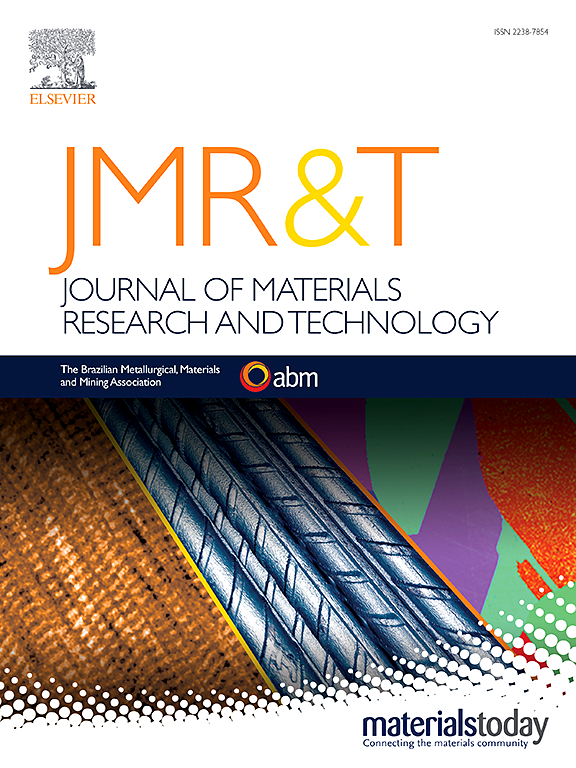Origin of the serrated flow and anomalous strength evolution in the severe plastic deformed 2195 Al–Li alloy
IF 6.2
2区 材料科学
Q1 MATERIALS SCIENCE, MULTIDISCIPLINARY
Journal of Materials Research and Technology-Jmr&t
Pub Date : 2025-06-13
DOI:10.1016/j.jmrt.2025.06.092
引用次数: 0
Abstract
This work investigates room-temperature serrated flow and anomalous strength variations in forged 2195 Al–Li alloys as functions of forging temperature, focusing particularly on dense dynamic strain precipitation of intragranular icosahedral quasicrystalline phases T2. To achieve this, 2195 Al–Li alloys were forged at temperatures ranging from 180 to 460 °C, reaching a maximum cumulative strain of 2.4, thereby ensuring comparable microstructure and microtexture while varying dynamic precipitation behaviors. The study reveals that forging between 220 and 380 °C significantly promotes dynamic strain precipitation of intragranular, globular icosahedral quasicrystalline phases T2 (Al6CuLi3) due to the high-density, strain-induced crystal defects, which provide enhanced diffusion pathways and sufficient energy to surpass nucleation barriers. The size and average spacing of T2 particles increase with higher forging temperatures, extending the dislocation arrest duration at these precipitates. Consequently, alloys forged within 300–380 °C exhibit intensified serrated flow and severe strain localization during room-temperature tensile tests, resulting in substantially lower tensile elongation compared to alloys forged above 420 °C. The tensile strength initially decreases and then sharply rises with forging temperatures from 300 to 460 °C, reaching a minimum at approximately 380 °C, coinciding with the precipitation or absence of T2 phases. This work paves the way for the designation of high-performance 2195 Al–Li alloys by hot deformation.
2195铝锂合金严重塑性变形中锯齿状流动的起源及异常强度演变
本文研究了锻造2195 Al-Li合金的室温锯齿状流动和锻造温度的异常强度变化,特别关注了晶内二十面体准晶相T2的密集动态应变析出。为了实现这一目标,2195 Al-Li合金在180 ~ 460℃的温度下锻造,最大累积应变达到2.4,从而在改变动态析出行为的同时保证了相似的组织和显微组织。研究表明,在220 ~ 380℃的锻造过程中,由于高密度的应变诱导晶体缺陷,显著促进了晶内球状二十面体准晶相T2 (Al6CuLi3)的动态应变析出,从而增强了扩散路径和足够的能量超越成核势垒。随着锻造温度的升高,T2颗粒的尺寸和平均间距增大,从而延长了这些析出相的位错止动时间。因此,在300-380°C锻造的合金在室温拉伸试验中表现出强化的锯齿流和严重的应变局部化,导致与420°C以上锻造的合金相比,拉伸伸长率大大降低。在300 ~ 460℃锻造温度范围内,抗拉强度先下降后急剧上升,在380℃左右达到最小值,与T2相的析出或不析出相一致。本工作为热变形制备高性能2195铝锂合金铺平了道路。
本文章由计算机程序翻译,如有差异,请以英文原文为准。
求助全文
约1分钟内获得全文
求助全文
来源期刊

Journal of Materials Research and Technology-Jmr&t
Materials Science-Metals and Alloys
CiteScore
8.80
自引率
9.40%
发文量
1877
审稿时长
35 days
期刊介绍:
The Journal of Materials Research and Technology is a publication of ABM - Brazilian Metallurgical, Materials and Mining Association - and publishes four issues per year also with a free version online (www.jmrt.com.br). The journal provides an international medium for the publication of theoretical and experimental studies related to Metallurgy, Materials and Minerals research and technology. Appropriate submissions to the Journal of Materials Research and Technology should include scientific and/or engineering factors which affect processes and products in the Metallurgy, Materials and Mining areas.
 求助内容:
求助内容: 应助结果提醒方式:
应助结果提醒方式:


